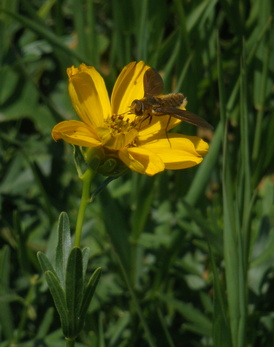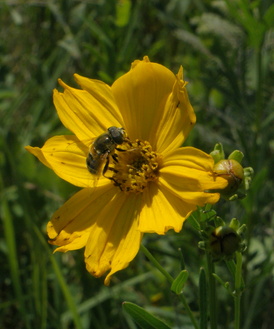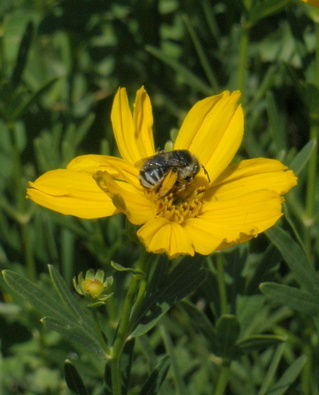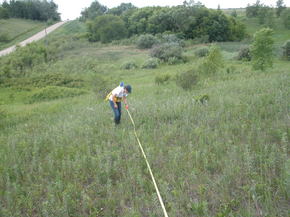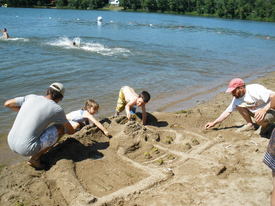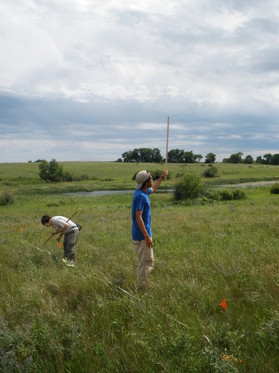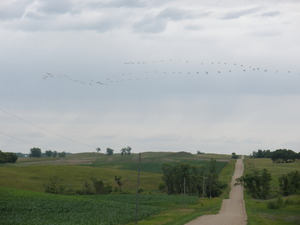|
|
So, I’ve been working hard creating slides from all the styles everyone helped to collect (thanks!), and this is the protocol I’ve been using:
II. SLIDE PROTOCOL:
A. ORGANIZE THE STYLE VIALS BY SITE
B. CREATE SLIDE LABELS
C. RANDOMIZE THE STYLE INFORMATION ON EXCEL
D. CREATE THE SLIDES IN THE RANDOM ORDER GIVEN BY EXCEL
1. Place the blank slide on a clean surface
2. Pull out the correct vial, open carefully (sometimes the styles are on the lid of the vial), use clean tweezers to remove the contents. Place vial contents onto the slide.
3. Remove any anther parts from the slide; organize the stigmas so they are separate/easily differentiated from each other.
4. Place one drop of glycerin on top of the stigmas. If there are any bubbles, try to move them away from the stigmas.
5. Place a cover slip carefully over the glycerin and allow it to settle.
6. Use mounting medium to seal the cover slip to the slide. Allow the slide to dry on a flat surface for 24-48 hours.
E. Put completed slides into slide boxes.
Of the approximately 380 slides I started with, I have 150 left to do, so I’m more than 1/2 way there. Once I’ve created all these slides, I’ll start taking photos and uploading pictures.
Anyway, just felt like it was about time I updated. Gonna go make slides now… ^_^
Here is the data that’s been compiled for FNC, pollinator observations, within 10 m, and the isolation measure of flowering Echinacea focal plants.
Some things I wanted to point out that may or may not make a difference:
>In the FNC data, all quadrants with none present have no data for distances, and sometimes there is only one distance if there was only 1 infl of a species within a quadrant…
>I still need to check each tag number that we recorded for FNC and make sure it coincides with the original record of tags we made when we flagged.
>For the isolation measure, I put in 11 for distances >10m. I marked the original distance in the notes in cases where they were >10m but measured out (i.e.SPP)
>For inflorescence counts>100, I put in 1000. In the comparison file below, we changed 1000 to 101 since we had to sum the inflct for each unique ID and so some of the infl ct were showing up as >1000.
ISOLATION.csv
FNC.csv
POLLOBSWITHFLIES.csv
POLLOBSWITHOUTFLIES.csv
WITHIN10M.csv
pollcomparison ecan mesa amca.csv
ech mesa comparison with mean std error.csv
ech amca comparison with mean sterror.csv
As of 8/3:The last 2 files are new. In order to make the graph that appears on my poster, we divided the unique Id’s into 4 groups: 1-alfalfa only in fl.neighborhood 2-ech only 3-both 4-neither. I took the average and standard error from each of those 4 groups to make the 4 bars on the graph. I want to do the same thing for Amorpha. So I attached the file that I’d use to make the same graph but with amorpha. You could use the third to last file which has infl ct for each unique ID for ecan, mesa, and amca to do the analysis but I figured I’d put the others up so you could know how I made the graph…
FYI, after Amanda and I looked at all the vials yesterday, it turns out that over our 4 day stint we had 132 bees, 13 scsf, 33 flies, 4 butterflies, 15 beetles. Good work everyone!
Greg and I have been collecting plants and pressing them. I am doing a plant collection with plants mainly from landfill for one of my classes next year at McGill in Plant Systematics. Greg is collecting specimens of anything that co-flowers with Echinacea and making slides with the pollen from each specimen to compare with the pollen found on the pollinators and styles from pollinator competition experiments. Greg, here is a site with information on collecting plants from the Missouri Botanic Gardens
Here is a document from my class that also describes field collection techniques:
HELPFUL HINTS2010.doc
I also made a drying box for the pressed plants, which is almost finished…
Gretel- KJ’s
Mimi- Railroad Crossing
Allegra- Landfill East
Stuart- Staffanson
Amy- Steven’s Approach
Amanda- Yellow Orchid Hill
Daniel- Aanenson
Kate- Riley
Caroline- On 27
Greg- Loeffler’s Corner
See you guys at 7:30ish at Hjelm House!
xoxo,
Amanda
We have made a few changes to the protocol for tomorrow’s FINAL outing for pollinator observation and collection:
1) DO NOT capture syrphid flies!
2) If you observe a small common syrphid fly (Family: Syrphidae, Sphaerophoria sp.) on your Echinacea head, make a note that one SCSF was observed. Here are some photos of syrphid flies:
http://echinacea.umn.edu/insects/images/poll2005vin1948side.jpg
http://echinacea.umn.edu/insects/images/poll2005vin1927top.jpg
http://echinacea.umn.edu/insects/images/poll2005vin1927front.jpg
Here’s a video that might help:
http://www.youtube.com/watch?v=UkjPfAMGmiw&NR=1
———————————————————————————————
As for pollinator collection and analysis…
We’ve gone out collecting three times now (tomorrow is the fourth and final day), and we have about 140 Echinacea insect visitors in vials in the freezer. Here is my protocol for making slides and labeling specimens:
1) Remove vial from the freezer and allow insect to thaw
2) Cut a very small (2mm cubed) piece of agar and situate it in the middle of a slide.
3) Remove the insect from the tube and dab and sweep every surface of the body across the agar cube. This is intended to simulate the amount of pollen that might be transferred to Echinacea styles during a visit.
4) Set the insect aside on Styrofoam.
5) Sweep the inside of the vial with the agar cube for any loose pollen.
6) Place a cover slip atop the agar cube and put the slide on the edge of a hotplate on LOW heat. Watch the slide carefully and remove it when the agar is soft but not melted (once melting starts, it will quickly boil and create bubbles in the slide).
7) Pin the insect (for identification if it is an unknown species, or quick-n-casual for a known species) and pin it with a new one letter, three number code.
8) Label the slide with the vial code and the specimen code.
Photos:
I photograph the slides on the same day as I make them so that the agar doesn’t dry out before the photo. To sample the slides, I have generated random pairs of numbers from 1 to 22 (inclusive). The cover slips are 22 x 22 mm and I use the ruler on the microscope to scroll to the randomly selected “plots” from one corner of the cover slip. From there, I take the photo at 40x. I take ten photos for each slide, and sometimes take more than one photo per plot if I capturing all of the pollen grains requires multiple focuses.
I will post some photos of this process soon, so hang in there!
As always, feel free to leave questions or comments.
Thanks!!
Amanda
On July 20th I collected pollen,separated into three microfuge tubes, from plant 36, 958. Tube #1 has been left at room temperature, #2 is in the refrigerator, and #3 is in the freezer. There wasn’t much pollen available, so I hope it’s enough to try some pollinations and see how long the pollen stays viable under the three treatments.
Here’s some of the work I’ve done with organizing my data. I still need to figure out how to organize it to be able to analyze it, so this is mostly just preliminary work. I have about 2 weeks to put this all together….any help/advice is appreciated because right now, the data I have is a little overwhelming. There are 3 sheets in this document.
Ech Guide to Co-Fl Sp.xls
For next week, it looks like the weather should hold up for Tues and Thurs to be able to do pollinator observations. So we will need to flag the sites on Monday and have everything ready to go for Tuesday. Remember, you ALWAYS record something for each observation you make, regardless of whether or not you observed/caught a pollinator. Select No for poll. observed and No for pollinator caught if this is the case. Some things I wanted to clear up for people helping with FNC:
>If you reach 100 when counting inflorescences, stop and record >100.
>When recording the species within 10m, you will no longer put this into a memo. Instead you will always select pl A, record 0 for infl ct, and in the field of quadrants, select the fifth option called “within 10m”.
>Review the guide to co-flowering sp for how to count infl or print one up and ask me if you have questions.
>If you come across a new species that isn’t in the list of species in the form, record in the notes not only the species but also a brief description of how you counted inflorescences.
Thanks!
Here’s some of the pollinators I saw on Coreopsis near Hegg Lake. They seemed to only be pollinating Coreopsis although there were other species like Achillea, Amorpha, and Echinacea around.




Kate and I made a list of species coflowering with Echinacea at Ri, LC, and rrx yesterday. These species are not within the 2m floral neighborhood, but are within 10 m of at least one of the observed plants. coflsp13jul2009.xls
Ech jenkins FNC protocol revised.doc
Ech Guide to Co-Fl Sp.xls
I have a photo guide but I can’t upload it b/c the file is too large.
If you plan on helping with FNC, please read the documents above. It’s important that everyone counts inflorescences the same way. Thanks!
Also, for tomorrow, there are a couple of notes I thought I’d add:
>Please make a note if you see ants on the head of the plant you are observing.
>Also make a note if it is mostly cloudy.
>Try to get to your site with about 10 min to spare so you can get your supplies ready and orient yourself with the placement of the flags to avoid time spent wandering in search of flags.
>Please try to start your observation as close to 8am as possible. End at 11am. Do not start an observation if you can’t finish by 11.
>Remember that you will only be collecting styles at the end of the observation pd from now on. Clean your tweezers with your shirt in between collections.
Thank you thank you thank you to everyone for helping this week. Just in terms of my project, we characterized floral neighborhoods for almost 70 plants in three days. In terms of pollinator observations, Tuesday’s escapades in the remnants were fruitful, but thursday’s weather would not hold out for us, so we had to postpone the second day of observations to next week, meaning we will have to randomly select a different set of 8 plants for all 10 remnants. I expect to see some more diversity in the neighborhoods next week because some species are just starting to flower like Coreopsis, Dalia, Apocynum, and Amorpha.
Here;s Amanda measuring to the nearest flowering Echinacea in Aanenson’s:

Here’s some pictures of our fun 4th of July and the amazing sustainable sandcastle.

Waniel, Per, and Hattie

Yesterday Daniel told us we could have a romantic walk in Staffanson Prairie if we came with him, but instead he made kate and I search his and Amy’s transects. What a trickster. Here he is cursing the heavens.

A flock of pelicans flew overhead at NWLF.

I have many more pictures http://picasaweb.google.com/mimijenkins/MinnesotaSummer09# in case you’re interested.
|
|

